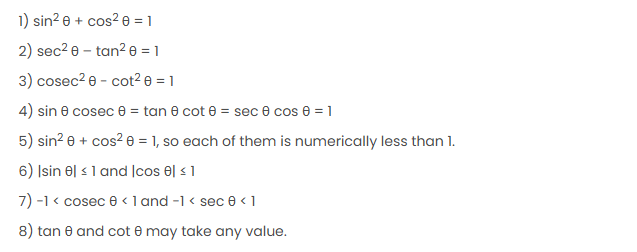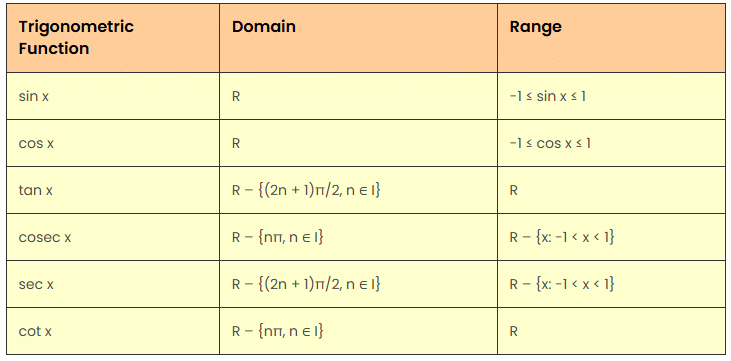Trigonometry is that branch of mathematics that relates to the sides and angles of triangles, especially in a right-angled triangle. One of the keys to solving questions from trigonometry in JEE Main is familiarity with its formulas. JEE Mains for Trigonometry has
- A weightage of around 7% in JEE Main
- Basic formulas of trigonometry play a vital role while solving questions.
- Every year, around 4-5 questions are asked directly from the topic in JEE Main.
Also, there are some more questions from other topics in which trigonometry is imbibed. Toppers recommend to learn all formulas and have conceptual clarity of their application to become a pioneer in this topic. Click here to read JEE Main Mathematics Syllabus
- Trigonometric Ratios and concepts are used in Algebra and Calculus (as a direct function or as a way to simplify functions).
- Questions can be asked from trigonometric identities, equations, heights and distances, and inverse trigonometric functions.

Must Read:
- JEE Main Study Notes on Statistics
- JEE Main Study Notes for Coordinate Geometry
- JEE Main Study Notes on Integral Calculus
Trigonometry JEE Main Formulas to Remember
Various trigonometry formulas related to the basic trigonometric ratios which must be remembered include:


Also Read
Important Topics in Trigonometry (Chapter-wise Weightage)
Below given is the weightage of important topics in trigonometry in JEE Main.
| Chapter | Weightage (out of 120 marks) |
|---|---|
| Trigonometric Identities | 5.67 |
| Solutions of Triangles and Heights & Distances | 1.33 |
Tip: Being an essential unit, it should be covered first at the time of preparation as it will help in other units.
Read JEE Main Mathematics Preparation Tips
Trigonometric Ratios (T-Ratios)
Trigonometric Ratios (T-Ratios)
To understand Trigonometric Ratios, we take a right angled triangle ABC, where ∠BAC = θ. Below mentioned are the trigonometric ratios for the angle θ.
Signs of Trigonometric Functions
Signs of Trigonometric Functions
Two perpendicular lines intersecting at a point O divide a plane in 4 right angles, each is called a quadrant. If θ be the angle that a line OA subtends with the initial line OX, anticlockwise then.
In I Quadrant, 0° < θ < 90°
In II Quadrant, 90° < θ < 180°
In III Quadrant, 180° < θ < 270°
In IV Quadrant, 270° < θ < 360°
The following table illustrates the sign of various trigonometric functions in all the four quadrants
| Quadrant I | Quadrant II | Quadrant III | Quadrant IV | |
|---|---|---|---|---|
| sin θ | + | + | - | - |
| cos θ | + | - | - | + |
| tan θ | + | - | + | - |
| cot θ | + | - | + | - |
| sec θ | + | - | - | + |
| cosec θ | + | + | - | - |
More precisely, we can discuss the way of increase and decrease of trigonometric functions as described in the following tables:
| Quadrant I | Quadrant II | Quadrant III | Quadrant IV | |
|---|---|---|---|---|
| sin θ | increases from 0 to 1 | decreases from 1 to 0 | decreases from 0 to -1 | increases from -1 to 0 |
| cos θ | decreases from 1 to 0 | decreases from 0 to -1 | increases from -1 to 0 | increases from 0 to 1 |
| tan θ | increases from 0 to | increases from -∞ to 0 | increases from 0 to ∞ | increases from -∞ to 0 |
| cot θ | decreases from ∞ to 0 | decreases from 0 to -∞ | decreases from ∞ to 0 | decreases from 0 to -∞ |
| sec θ | increases from 1 to ∞ | increases from -∞ to -1 | decreases from -1 to -∞ | decreases from ∞ to 1 |
| cosec θ | decreases from ∞ to 1 | increases from 1 to ∞ | increases from -∞ to -1 | decreases from -1 to -∞ |
Basic Formulae of Trigonometric Functions
Also Read
Basic Formulae of Trigonometric Functions
- sin θ . cosec θ = 1 or
- cosθ . sec θ = 1 or
- tan θ . cot θ = 1 or
Graphs of Trigonometric Functions
Graphs of Trigonometric Functions
- Graph of y = sin x
- Graph of y = cos x
- Graph of y = tan x
- Graph of y = cot x
- Graph of y = sec x and y = cosec x
- Graph of y = 3 cos 2x
Graph of similar trigonometric functions can be obtained in a similar way.
Values of Trigonometric Ratios of Some Important Angles
Also Read
Values of Trigonometric Ratios of Some Important Angles
Table of Trigonometric Ratios at Standard Angles
Table of Trigonometric Ratios at some Specific Angles
Trigonometric Ratios of Compound Angles
Trigonometric Ratios of Compound Angles
- Conversion Table for T-Ratios of –θ in terms of T-Ratios of θ.
sin (– θ) = – sin θ, cos (– θ) = cos θ,
tan (– θ) = – tan θ cot (– θ) = – cot θ,
sec (– θ) = sec θ, cosec (– θ) = – cosec θ
- Conversion Table for T-Ratios of
in terms of T-Ratios of θ
- Conversion Table for T-Ratios π ± θ in terms of T-Ratios of θ
sin (π − θ) = sin θ sin (π + θ) = − sin θ
cos (π − θ) = – cos θ cos (π + θ) = − cos θ
tan (π − θ) = – tan θ tan (π + θ) = tan θ
cot (π − θ) = – cot θ cot (π + θ) = cot θ
sec (π − θ) = – sec θ sec (π + θ) = − sec θ
cosec (π − θ) = cosec θ cosec (π + θ) = − cosec θ
- Conversion Table for T-Ratios of
in terms of T-Ratios of θ.
- Conversion Table for T-Ratios of 2π ± θ in terms of T-Ratios of θ.
Trigonometric Ratios of Sum and Difference of Angles
Trigonometric Ratios of Sum and Difference of Angles
,
,
Trigonometric Functions of Multiple and Sub-Multiple Angles
;
;
;
;
;
Methods of Solving Trigonometric Equations
Methods of Solving Trigonometric Equations
Factor Method
Example : Solve : 2 cos x cos 2x = cos x.
Solution : The given equation is equivalent to the equation cos x (2 cos 2x –1) = 0. This equation is equivalent to the collection of equations
Answer :
Reduce to Quadratic Equations
Example : Solve the equation 3 cos2x – 10 cos x + 3 = 0.
Solution : Assume cos x = y. The given equation assumes the form 3y2 – 10 y +3 = 0. Solving it, we find that
The value y2 = 3 does not satisfy the condition since | cos x | ≤ 1. Consequently,
Answer :
Solving Equations by Introducing an Auxiliary Argument
Equations of the form a sin x + b cos x = c can be solved by dividing the two sides of equation by and substituting
Example : Solve the equation sin x + cos x =
Solution :
or
Answer :
Use of Half Angle Formulas
Example : Solve :
Solution : cos x – (1 – cos x) = 0
Answer :
Solved Examples of Trigonometry
Solved Examples of Trigonometry
Question: If k = sin (π/18) sin (5π/18) sin (7π/18), then what is the numerical value of k?
Solution: The value of k is given to be k = sin (π/18) sin (5π/18) sin (7π/18).
Hence, k = sin 10° sin 50° sin 70°
= sin 10° sin (60° - 10°). sin (60° + 10°)
= sin 10° [sin 260° - sin 210°]
= sin 10° [(√3/2)2 - sin 210°]
= sin 10° [3/4 - sin 210°]
= 1/4 [3sin 10° - 4sin 310°]
= 1/4 x sin (3 x 10) (since, sin 3θ = 3sin θ- 4sin 3 θ)
= 1/4 sin 30° = 1/8
Question: Evaluate the value of (1 + cos π/8) (1 + cos 3π/8) (1 + cos 5π/8) (1 + cos 7π/8).
Solution: The given expression is
(1 + cos π/8) (1 + cos 3π/8) (1 + cos 5π/8) (1 + cos 7π/8)
= (1 + cos π/8) (1 + cos 3π/8) (1 - cos 3π/8) (1 - cos π/8)
= (1 – cos 2π/8) (1 - cos 23π/8)
= ¼ [2 sin π/8 sin 3π/8]2
= ¼ [2 sin π/8 cos π/8]2
= ¼ [sin π/4]2
= 1/4. 1/2 = 1/8
Also Read
Tips to Study Trigonometry for JEE Main
Trigonometry is a chapter in JEE Main 2026 Mathematics where application of formula is really important. Thus it is important to study the topic in a manner that leads to quick solution of problems. Some of the tips have been given below.
- Read the theory ONCE, but give formulas a reading of two to three times. Mugging up theorems is not at all suggested.
- Solve problems and focus more on the equations part by applying the formulas that you have read. Constant application will help you getting well-versed with formulas.
- Studying this topic from 2 good sources will be enough as the kind of questions that will come from this topic are almost similar.
- You can make a formula sheet and have a look at it initially when you get stuck, and things will slowly get etched into your brain.
- Don’t forget to go through the previous year JEE Main question papers.
With the application of above tips, students opting for JEE Main or any other paper for that matter will sure be able to crack questions from Trigonometry in the least time possible. No matter how tough the topic seems to be, constant practice will lead you to ace the paper.




Comments